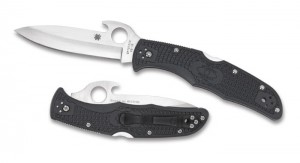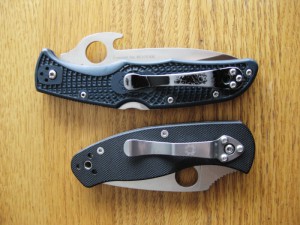Back in mid-January, I ordered and received a Spyderco Endura 4 Wave, and, while I wanted to review it right then and there, I decided to wait until I’d tested it a bit more. That time has come.
“Spyderco is a company, founded in 1978 by Sal Glesser and based in Golden, Colorado, U.S.A., that produces knives and knife sharpeners.” Thus says Wikipedia (and, incidentally, they’re right). They also have only 38 employees, which I think is pretty cool; it gives that small business feel and attention to detail. Anyways, Sal Glesser was the first, back in 1981, to think of and implement the pocket clip. He also introduced one-hand opening, with the signature Spyderco thumb hole. And serrations. In other words, he shaped the knife industry and made the “tactical knife” possible.
The Endura and it’s smaller counterpart, the Delica, were launched in 1990 as lightweight, affordable pocket knives. Since then, they’ve undergone improvements with each generation, this being the 4th (hence Endura 4). Pricing on the Endura runs from $60 to $115 (I got mine for $61). The knife measures 8 3/16 inches when open and 5 inches closed (the handle length). That leaves 3 13/16 inches for the blade, 3 7/16 of which are cutting edge. For its dimensions, the weight is a fairly light 3.6 oz, partly due to the skeletonized steel liners. Granted, the previous generation was lighter at 3.0 oz, but it lacked the additional strength of steel liners, which I think justify the weight. Opinions differ, however.1
I just like the fact that it is a more rugged knife, regardless of whether the reinforcement is necessary or not. There is always the potential situation wherein you are sliding down the conical roof of a grain silo towards a 200-foot fall and certain death; dragging your fingernails has availed naught. Wha-chawww! You draw your Endura Wave and open it in one fluid motion, driving it desperately into the thin aluminum sheeting. It bites deep and torques under your weight, but holds, thanks to the tensile strength of the steel liners! Besides, that steel gives the pocket clip screws something more to tie into, and I hate wiggly pocket clips.
Build quality is excellent on the Endura I reviewed, the fit and finish near perfect. The handles are made of FRN (Fiberglass Reinforced Nylon), tough and resilient. I’ve dropped mine on asphalt and concrete with minimal scuffing to the blade and handles, and most of that has buffed itself out, excepting one shallow but visible nick.
The pocket clip, as I’ve already mentioned, holds up well. (And well it should—Mr. Glesser invented it!) The black paint looks good, but, like all painted or un-painted pocket clips, it scratches when you scrape it against rocks and concrete and so forth.2 As you can see in the picture, it’s held in place by three screws positioned in a semi-arc. Not quite so solid as the setup on the Drifter, but adequate. And even the best clip can fail: I caught the Drifter clip on a vinyl chair the other day and bent it (CRKT sent two replacement clips free of charge). But with the longer clip and smaller screw base, leverage is greater on the Endura, and the screws did loosen. And I hate wiggly pocket clips.
However, the screws are fairly long and do tighten up nicely into the steel liners. I just had difficulty finding the necessary Torx set, but, after searching all our local hardware stores, I bought one online. I used some LocTite on the screws and set them tightly, and it hasn’t budged since (an impressive feat, considering the five weeks of active construction and trail-clearing work I’ve carried it through). To summarize, I really like Spyderco’s clip design: the shape, tension and flared tip lend superior ergonomics. I think the size ratio is right on, and despite a questionable screw array, remains secured extraordinarily well. (Incidentally, the Torx size was TX9 for the pivot screw and the rest are TX6, for those interested.) Finally, the clip may be moved to any corner of the knife to accommodate tip-up, tip-down, left- or right-handed carry.
The blade is 3 13/16 inches long, and made of the excellent VG-10 steel.3 I have noticed some side-to-side blade play, but I read somewhere that this has to do with the way it’s engineered for maximum strength. Besides, you can tighten it simply by adjusting the pivot screw; I just like it loose enough where it opens easily.
The Emerson or “Wave” opener is the wave-shaped hook on the top of the blade that works by catching the seam of your pants as you pull it out of your pocket. Here is a good video review that shows how the opener works (frame-by-frame pictures here), and another more humorous use. It is the result of a collaboration with Emerson knives; owner, knife-maker and martial arts expert Ernest Emerson designed the “Wave” opener for his distinctive tactical knives. Combined with the Endura 4, the result is a fast and affordable tactical knife. The deployment—gliding on phosphor bronze bushings—is wicked smooth and scary fast, as this guy demonstrates. The Spyder-hole, the regular opening method, is funky but attractive and works well, especially with cold fingers, gloves or big hands where a thumb stud would fall short. It was also, as mentioned above, the first one-handed blade-opening device.
The lock system is a lockback—more solid than most, if not all, linerlocks (although the LAWKS system feels comparable). The lockback mechanism also features the Boye indent in the release lever, which is “a half-moon of steel removed from the locking lever,” designed to “[make] the knife impossible to accidentally close when gripped very tightly.”4 The lockback is also a bit more awkward to close with one hand than linerlocks. It can be managed, however, and I will hopefully be posting a video soon to demonstrate a few methods.
I would call the intended application for this knife EDC (Every Day Carry) and light tactical. The length of the blade takes away much of your precision control, making food prep (like peeling an apple) and other tasks requiring fine-grained control difficult. You can, however, choke way up on the handle and brace your thumb against the opening hole, and gain some manipulability that way. On the positive side, the long blade (almost 4 inches) gives you lots of reach in defensive situations, and the long handle ensures you won’t lose your grip: you can hold the knife farther back on the handle and gain an extra inch of reach, or you can choke up to the thumb ramp for a solid thrust. It’s got a good stabbing point and a rock-solid reverse grip, but unfortunately not a whole lot of slashing belly (compared, for instance, to the Persistence). Finally, the Endura has really nice, functional jimping, both on the thumb ramp and on the plastic behind it, giving your thumb plenty of purchase.
My first impression of the Endura was that, like a ThinkPad, the knife is sturdy and rugged, and even attractive after a fashion. I fell in love with the snick of the lockback. I should note in closing that, while many online pictures and descriptions give the color as dark grey, almost black, the true color is more of a slate blue. (You can see the discrepancy between the two pictures I’ve posted.) The Endura came “shaving” sharp, as it should. I’m quite pleased with my Endura, and most exceedingly so with the excellent Persistence, with the result that I plan on buying more from Spyderco—possibly a Tenacious or FFG (Full Flat Ground) Delica.
- Nutnfancy later at least commends the Endura 4 as an example of well-executed steel liners, even if he would have left them out. See this video, in the annotation at the 5:35 mark. ↩
- I’ve since acquired a Spyderco Persistence, and find its plain steel clip even more attractive, and there’s no paint to scratch off, giving it the Endura’s scuffed look. ↩
- Nutnfancy demonstrates the intense awesomeness of this steel here. ↩
- Quoted from a Spyderco News page here. ↩

Comments are disabled for this post